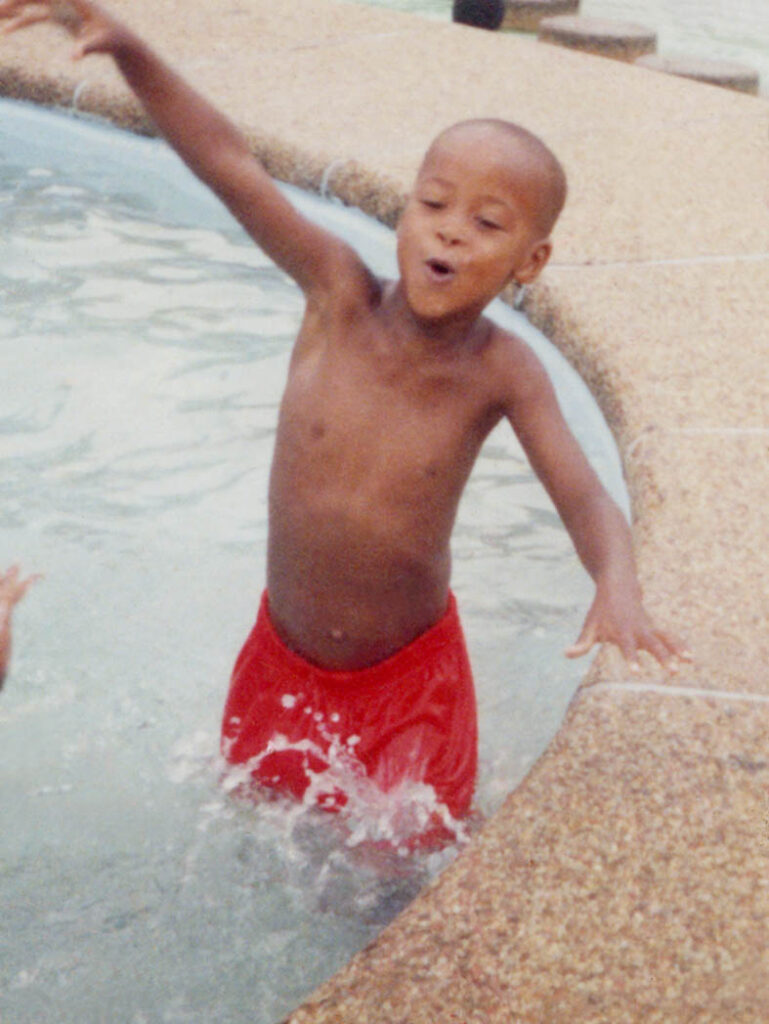Untitled 21 (January 1st, 2020), 2021 (from the ongoing series eBhish’)
eThekwini is home. Growing up, summers were often the highlight of the year. My family and I would drive to the beach in a minibus taxi or bus packed to the brim with camp chairs, cooler boxes and treats. En route, as kids, we would sing gleefully, “eBhish’ Durban, ebhish’, bhish’, bhish’, Durban!”
This excitement reverberated with crowds of other kids, who would splash about the public pools. I have fond memories of a mixture of sea water and chlorine. I’d often swim for hours until uMa noma uGogo would drag me out of the pool.
Like many people, Ibhish’ laseThekwini (the Durban beachfront) holds a lot of personal, as well as political, significance. In many ways, mounting eBhish’ at the KwaZulu-Natal Society of the Arts (KZNSA) Gallery signals a return home to have a conversation with myself — witnessed by my family and iTheku — who shaped the body of work. This full-circle moment is interlaced by questions I’ve been toiling with about my work and practice.
eBhish’ is on exhibit in all three galleries. The multi-floor space is vast, and has a high ceiling, which facilitates an opportunity to present the multimedia series in its entirety — placed in groups; and, at times, individually — across the galleries. Through this iteration, I’m able to present the three-channel video piece allowing for an immersive viewing experience. The sonic piece spills throughout the space, scoring the display with textured accounts of the beach from friends and family.
An exhibition space is integral to the experience of the show. Although the exhibition debuted at Blank Projects in Cape Town in July last year, the atmosphere at the current iteration is entirely different. This is largely because of geography, proximity and audience. Some of the people engaging with the work have experienced the beach in its various H(h)istories and its contentious present and bring a particular nuance to the conversation. This presents a mirroring.
 Luvuyo Equiano Nyawose, eBhish’ laseThekwini, 1998
Luvuyo Equiano Nyawose, eBhish’ laseThekwini, 1998
eBhish’ is a self-reflexive endeavour; a personal archive. But it’s also a collective one. Through my multimedia work, I foreground the multiplicity and fluidity of black oceanic presence and black subjectivity, as well as the interrelated meanings of amanzi (water) and ulwandle (the sea) as spiritual.
Overall, the reaction to eBhish’ has been overwhelming. For some viewers, it is a moment to reminisce and contemplate the finer happenings of public seaside moments of black social life: the tenderness, the softness, the public communion.
There was a particular encounter at the KZNSA opening that stayed with me. Photographer Thembi Mthembu shared that she has had a moment to pause and reflect on the vastness of the work. “We don’t often publicly get to pause and reflect,” she said.
As I reflect on eBhish’, I cannot ignore two crucial moments. In the context of the Covid-19 pandemic, the beachfront is a very different space. During the summer peak period 16 December to 2 January, the beach has been significantly emptier than usual.
There is a sense of loss — a mourning of gathering in public and being in communion. The public swimming pools have been drained of water. However, some kids continue sliding into the empty pools, each taking turns.
The exhibition debuted in July 2021 in the wake of a turbulent period of what became publicly known as “riots” and “looting”, which among many things, unveiled the cracks of our fragile democracy. I cannot place eBhish’ too far from these moments. As poet Guérin reminds us on Twitter, even as we face “loss upon loss upon loss, still — somewhere — there are spaces for possibility”.
eBhish’ runs at the KZNSA Gallery until 27 February